
...
16 March / 21 April 2024
LAURA WOODWARD
This Fearsome Drop
In the early phases of developing this exhibition, Woodward drew some strange amorphous forms in her sketchbook. The word “amoeba” came to mind. In exploring what amoebas actually are, beyond a unicellular organism, she came across the following description:
“Amoebas move by using [temporary] bulging parts called pseudopodia… These are extensions of the cell’s membrane. An amoeba can reach out and grab some surface with a pseudopod, using it to crawl forward… Pseudopodia also help amoebas eat. A stretched-out pseudopod can engulf an amoeba’s prey. That allows this microbe to swallow bacteria, fungal cells, algae — even small worms.*1”
In the early months of her third pregnancy, Woodward was struck by the resonances of this description of what happens inside a gestating body.
The way in which the human foetus overtakes the mother’s body during pregnancy has this feel about it. The foetus needs iron, it pulls whatever iron is available from its host, irrespective of the mother’s needs. Calcium? Strip it from her bones. The foetus also leaves behind remnants of its DNA in the mother’s body – known as microchimeric fetal cells *2 – forever altering her genetic and cellular profiles.
Woodward sees these amoebic, pseudopodic tendencies in this sense of the micro, single-body resource-hoarding which happens between mother-as-host and baby-as-parasite. However, watching some videos of amoebas in action, she was struck by how analogous their activity is with the macro level of human behaviour. Millions of tiny individual cellular units move together to grab resources. This image of a microscopic cellular structure can be equally read as a mapping of human expansion – of taking resources because they are there, of over-draw, of morphing, of reaching and stripping wherever resources are available.
So, this has become an exhibition about resources, about life-bearing, breathing, and standing on a precipice. Of the tension between the personal choices that we make in bringing children into the world, and the societal and global considerations and impacts of these choices. Of literally keeping things alive: foetuses, children, eco-systems, humankind. About standing on the edge of climate collapse. About our insatiable drive for technology and its increasing creep into the deepest of evolutionary impetuses – that drive to procreate. About the sensation of holding tiny, fragile things in our hands. Of how a single drop of matter can lead to a whole life, an entire potential for love, care, power, destruction and joy.
At the edge of this fearsome drop, we stand. Holding onto hope for life – again, and then again, and then again.
…..
*1.Kwok, Roberta, “Amoebas are crafty, shape-shifting engineers”, Science News Explores, 17 January 2019, accessed 2 March 2024, https://www.snexplores.org/article/amoebas-are-crafty-shape-shifting-engineers
*2.Shute, Nancy, “Beyond Birth: A Child's Cells May Help or Harm the Mother Long after Delivery”, Scientific American, 30 April 2010, accessed 2 March 2024, https://www.scientificamerican.com/article/fetal-cells-microchimerism/

















